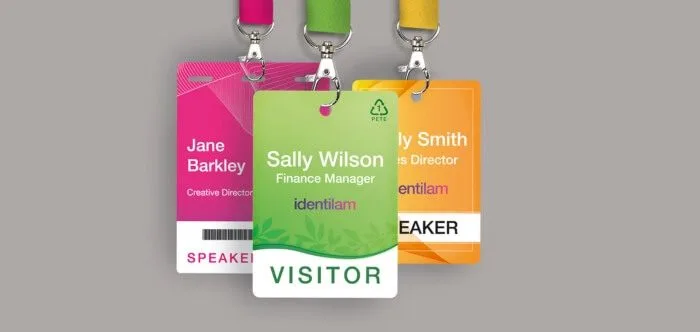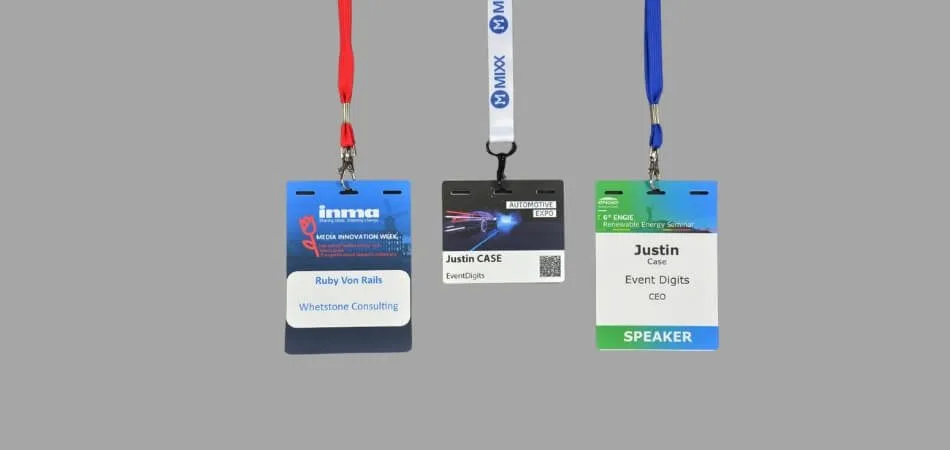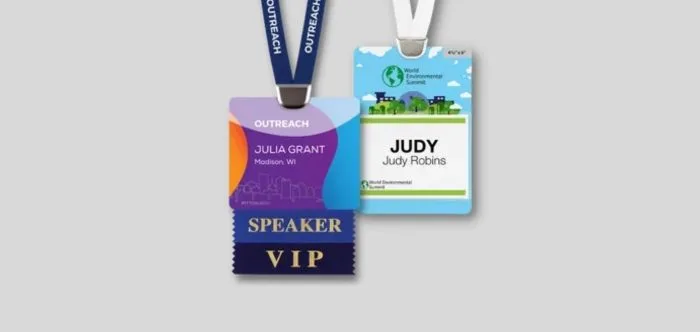Conference badges are an essential element in any professional gathering, serving as both a practical tool and a networking facilitator. A common query among event organizers is, “What size are conference badges?”
Typically, these badges measure around 4 inches by 3 inches (10 cm by 7.6 cm), a dimension that strikes the perfect balance between visibility and convenience. This size ensures that the text and logos are easily readable while the badge remains comfortable and discreet for attendees to wear throughout the event.
In this article, we dive deeper into the importance of selecting the right size for conference badges, along with tips on design and customization. Stay tuned as we explore how to make your conference badges both functional and memorable.
What’s the Purpose of Conference Badges?
Conference badges serve a central role in facilitating networking at events. They allow attendees to identify each other, facilitating interaction and communication easily. These badges also act as icebreakers, making introductions smoother and more approachable, especially when designed to the standard conference badge size, which ensures readability and visibility.

A well-regarded event organization requires badges in addition to identification. They help distinguish between different types of participants, such as speakers, guests, and staff. This differentiation streamlines event management and enhances the overall experience for everyone involved.
Additionally, conference badges can serve as keepsakes, preserving memories of the occasion. They are often customized with event branding, making them unique keepsakes. This aspect adds emotional value to the badges, extending their purpose beyond just practical functionality.
What Should Be Included in a Conference Badge?
Beyond their use as identifying markers, conference badges are crucial for networking, security, and improving the overall experience of the event. A well-designed badge can make a significant difference in how attendees interact and explore the conference. Here’s what should be included to maximize their effectiveness.
Attendee’s Name
The most prominent feature should be the attendee’s name. It should be printed in a large, readable font to facilitate easy recognition. This helps break the ice and encourages networking, as people can address each other by name. Ensuring the name is the most visible element eliminates any awkwardness in introductions.
Affiliation or Company
Including the attendee’s company name or affiliation provides context for their presence at the conference. It aids in identifying potential professional connections and fosters networking opportunities. This information should be less prominent than the name but still easily readable. Knowing a person’s professional background can stimulate conversation and connections.
Role or Title
Identifying the attendee’s role or title can be beneficial, especially in industry-specific conferences. It helps in understanding their expertise and the perspective they might bring to discussions. This detail is crucial for facilitating targeted networking and collaborations. Titles should be concise to keep the badge uncluttered.
Event Branding
The conference’s logo or branding should be included to reinforce the event’s identity. It helps in creating a sense of unity and belonging among attendees. Additionally, it makes the badge a keepsake that reminds attendees of their experience. The branding should be visually appealing but not overpower the essential information.
QR Code or Barcode
For tech-savvy events, including a QR code or barcode can streamline many processes. It can be used for checking into sessions, exchanging contact information, or accessing event material. This feature should be discreet yet easily scannable. Implementing technology in this way can enhance the overall event experience.
Custom Fields for Specific Events
Some conferences might require additional information like session tracks, dietary preferences, or accessibility needs. This information should be included if relevant to the event’s logistics and attendee experience. However, it’s important to balance the amount of information to avoid clutter. Tailoring the badge content to the event’s specific needs can greatly improve functionality.
What Size Are Conference Badges?
Conference badges, a staple at professional gatherings, typically measure around 4 inches by 3 inches (10 cm by 7.6 cm). This size is a result of carefully balancing several key factors, ensuring the badges are both functional and comfortable. Here are the factors that are involved in conference badge size:
Visibility and Readability
Visibility is the first consideration when determining badge size for conferences. Badges need to be large enough to read from a reasonable distance, ensuring attendees can identify each other without strain. When organizing conference name tags, it’s crucial to consider how the size will enhance interaction by making introductions smoother.
Readability goes hand in hand with visibility. Text on badges should be clear and legible, even from afar. Balancing text size with badge dimensions ensures essential information, like names and titles, is visible and easy to read.
Content Requirements
The amount of information to be displayed affects badge size. Badges often include names, titles, and company logos, all of which require space. Ensuring the badge size accommodates this content without clutter is crucial.
Moreover, badges might also feature QR codes or additional event-specific details. The inclusion of such elements requires careful consideration of the badge size, ensuring all content is presented effectively without overwhelming the design.
Event Type and Venue
The type of event influences badge size decisions. Formal conferences may require larger badges for clearer identification, especially in larger venues where distances between attendees are greater. Badge size should be suitable for the formality and scale of the event.
Venue size also plays a role. In spacious venues, badges must be large enough to maintain visibility across distances. Smaller, intimate settings may allow for more compact badge sizes, focusing on closer interactions.
Attendee Comfort
Comfort is a significant factor when selecting badge size. Badges should be large enough to be effective but not so large that they become cumbersome for attendees to wear. Balancing size with comfort ensures participants are not burdened by their badges.
Additionally, the weight of the badge can impact comfort. A heavier badge, due to its size or materials, may cause discomfort during extended wear. Choosing a size that maintains comfort while serving its purpose is essential.
Design and Aesthetics
Design considerations also play a vital role in determining badge size. A well-designed badge should balance aesthetics with functionality, ensuring it looks appealing while still being practical. The size must accommodate design elements without compromising on visibility or readability.
Aesthetics are important, especially for branded events. The badge size should allow for logos and colors to be displayed prominently, contributing to the overall event branding and attendee experience.
Why does the Specific Size of the Conference Badge Matter?
The size of conference badges has a significant impact on the overall experience of an event; they are more than just a tool for identification. Having a badge that’s the right size assists networking, ensures readability, and contributes to the organization of an event. Here’s why the specific size of the conference badge matters:
- A properly sized badge ensures attendees can easily read names and titles from a comfortable distance. This visibility facilitates smoother and more efficient networking.
- Badge size directly influences comfort, allowing attendees to wear them throughout the day without inconvenience. Uncomfortable badges can negatively affect the participant’s experience.
- The size of the badge allows for the inclusion of essential details like names, titles, and logos. Properly displaying this information prevents overcrowding and maintains clarity.
- A well-sized badge can reinforce the event’s branding by prominently displaying logos and colors. This visual element contributes to the overall aesthetic and professionalism.
- Larger badges can help distinguish between different participant roles, such as speakers or staff. This distinction aids in event management and attendee interactions.
How to Find the Right Size Badge for the Conference?
As you can see in our earlier discussion, it is important to consider a variety of factors when choosing the right size for a conference badge. A well-sized badge enhances the overall event experience, making it easier for attendees to connect and engage. Here’s a step-by-step guide to help you determine the right size.
Step 1: Assess the Information to Include
Begin by evaluating the content that will be displayed on the badge, such as names, titles, and company logos. Understanding the purpose of a conference badge ensures that all necessary details fit comfortably without overcrowding. Consider any additional elements like QR codes or event branding that may require extra space. Balancing this information will guide you toward an appropriate size.
Step 2: Consider the Event’s Venue Size
Take into account the size of the event’s venue when determining badge dimensions. Larger venues may require bigger badges for better visibility, ensuring attendees can easily identify each other. Conversely, smaller venues might allow for more compact badges, focusing on closer interactions. The venue size plays a key role in deciding how large the badges should be.
Step 3: Balance Aesthetics with Functionality
Ensure that the badge size accommodates both design and readability without compromising either aspect. A visually appealing badge should still serve its practical purpose effectively. The size must allow for clear text and images while maintaining an attractive design. Striking the right balance will result in a badge that’s both functional and aesthetically pleasing.
Step 4: Factor in Attendee Comfort
Keep attendee comfort in mind by selecting a size that’s easy to wear throughout the event. Overly large or heavy badges can cause discomfort and distraction. Opt for a size that participants can wear effortlessly, allowing them to focus on the event. Comfortable badges contribute to a more enjoyable experience for all attendees.
Step 5: Test and Adjust if Necessary
Before finalizing the badge size, create prototypes and test them under real conditions. Check for readability, comfort, and overall appearance to ensure everything aligns with your expectations. Make adjustments if necessary to refine the size, ensuring it meets all the event’s requirements. Testing helps avoid last-minute issues and ensures the best outcome.
Frequently Asked Questions about What Size are Conference Badges?
Choosing the right size for conference badges is crucial for ensuring visibility, comfort, and functionality. Below are some common questions related to conference badge sizes and their answers to help you make an informed decision.
What is the standard size for conference badges?
The standard conference badge size typically ranges from 3 x 4 inches to 4 x 6 inches. This size is ideal for including necessary information like names and logos while ensuring the badge is easy to read and wear.
Why is badge size important at conferences?
Badge size is essential because it affects readability and attendee comfort. A well-sized badge allows attendees to identify each other quickly and comfortably, enhancing networking opportunities and the overall event experience. It also accommodates essential details like names, titles, and branding.
Can the badge size vary depending on the event?
Yes, badge size can vary based on the event type and venue. Larger events may require bigger badges for visibility, while smaller, intimate gatherings might opt for more compact badges. The size is often adjusted to suit the specific needs of the event.
How do you determine the right badge size?
To determine the right badge size, consider the amount of information to include, the event venue, and attendee comfort. Testing different sizes before the event can help ensure the badge is functional, comfortable, and meets the event’s requirements.
Are there any guidelines for designing conference badges?
Designing conference badges involves balancing aesthetics and functionality. The badge size should accommodate clear text, logos, and additional elements like QR codes without clutter. Ensuring the badge is easy to read and comfortable to wear is key to effective design.
Bottom Line
The dimensions and design of conference badges are crucial for any successful professional gathering. The question “What size are conference badges?” is central to this discussion, highlighting the importance of a 4×3 inch standard size that expertly balances visibility, comfort, and customization.
This optimal size not only facilitates effortless networking and clear identification but also ensures attendee comfort throughout the event. Moreover, it provides sufficient space for branding and individualization, enhancing the badge’s role as a memorable keepsake.
The thoughtful consideration of badge size, content, and design underscores its significance in event organization, security, and overall attendee experience. By prioritizing these aspects, organizers can significantly uplift the impact and efficiency of their events.







